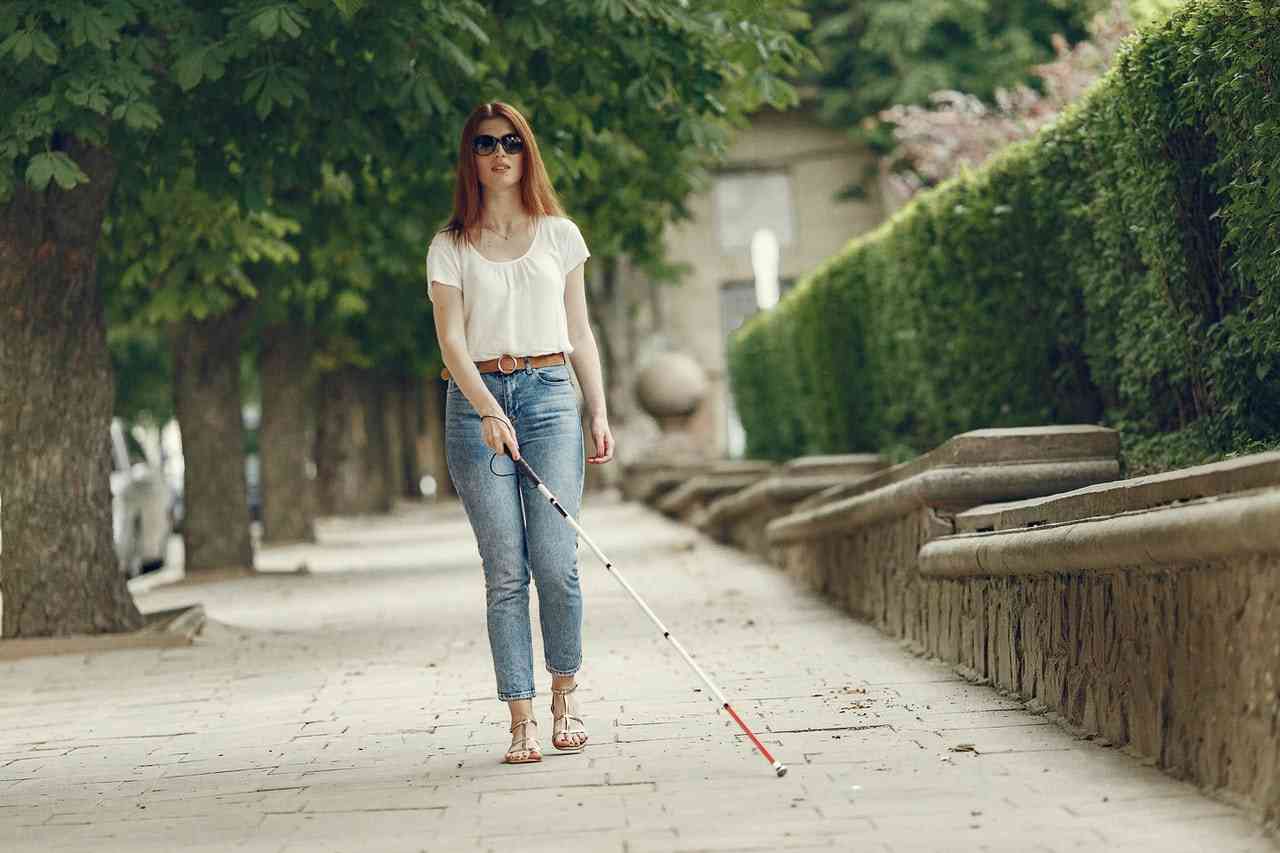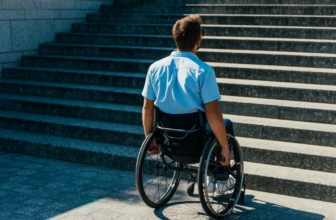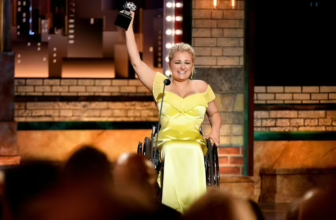If you or someone close to you is living with total blindness or low vision, you are probably familiar with the device called a long white cane.
This article is for you if:
- You have never used a cane before and you are wondering if it’s right for you
- You are wondering what skills you would need to start your white cane training and who can help you with that
- You are hesitant to get a cane and are looking for something else to replace it with
- You don’t know how to choose the right cane for your needs
You will learn:
What is a white cane?
The white cane is the most popular, proven, classical, and common device used by people who have total blindness or low vision to walk safely and independently.
Who needs a white cane?
A white cane is used by people with total blindness or partial loss of vision. You don’t have to be totally blind to use a white cane. If you have low vision or your vision changes with time and location (f.e, you see well in the sunlight but you can’t see in the shade; you have no problem going upstairs but downstairs is way more challenging), you can use some of the smaller and shorter types of canes, or choose a foldable cane that you carry with you and use only when you need it.
What types of white canes are there?
Long white cane
This is the classical and most commonly used cane. It is recommended that people with total blindness or vision loss that is severe enough to disrupt the perception of their surroundings (f.e., people with total loss of peripheral vision) choose this type of cane.
Guide cane
This is a shorter and smaller cane, usually made of aluminum. It can be used for finding obstacles such as stairs and curbs. This type of cane is NOT recommended for people with total blindness or severe vision loss, but for people who have partial vision and need a cane only in some cases, as an additional assisting device.
Symbol cane
This cane is smaller and thinner than the guide cane. It’s useful for people with low vision for navigating through busy locations and signaling to others that its user is a person with a visual disability.
What do I need to remember when choosing a white cane?
When you are choosing a long white cane, make sure it's long enough — it should reach your sternum and not be shorter because this would make you bend your body while using it for some techniques. This will quickly lead to muscle or joint pain, fatigue, and bad posture. Regarding the design of the handle, the type of the tip, and if the cane should be foldable or not — it’s your choice and a matter of preference. Talk to a qualified Orientation and Mobility instructor and discuss which option would be best for you.
What will the white cane do for me? What are its limitations?
The white cane will help you find obstacles in your way and go around them when you walk indoors and outdoors. It will help you find your way by using tactile orientation marks that are mostly on the ground and in close proximity to you. The white cane will also signal to other people around you that you are someone with a visual disability. Even though the white cane is extremely useful in most cases, it is not perfect. It is hard to use when the wind is very strong, for example. The cane will not detect an obstacle that is above the waist only – such as a tree branch or a low balcony.
The white cane is not a self-defense tool, nor a pointer, and it shouldn’t be waved around and lifted above the waist, except for some very rare cases, such as the S.O.S. sign with the white cane. Remember to never use your white cane to lean on! As white canes are produced to be as lightweight as possible, they are not sturdy enough to support your weight. Their tips are made to roll or glide on the ground and not to stand firmly. If you try to use your cane for this purpose, there is a great chance it breaks, bends, and becomes unusable, and you'll sustain a bad fall.
Can I use a guide dog instead of a white cane?
People who use guide dogs prefer to use a shorter and smaller cane — the long white cane can get in the way of the dog and it’s usually not necessary. Some people don’t use a cane at all while with the dog, but this is usually when walking in a safe and familiar environment. There are different rules depending on where you are, but in most cases, before getting a guide dog, you will be required to go through a basic Orientation and Mobility training and learn the white cane techniques very well. Even if you are not formally required to go through an Orientation and Mobility training before getting a guide dog, I strongly advise you to do so.
Can I use a GPS instead of a white cane?
You can use a GPS with the cane but not instead of it, especially if you have total blindness or a vision loss that is severe. GPS may help you with finding your way from point A to B, but it will not warn you of the obstacles in your way. Using GPS, apps for people with visual impairments, or other technical devices, together with the white cane is recommended mostly to advanced users. For a beginner, focus on your basic Orientation and Mobility training, learn the cane techniques to perfection, start learning small and easy routes that you use on an everyday basis and gradually progress to more complex and difficult routes. Once you learn how to navigate confidently through a few more complex routes, you can start using a GPS as additional assistance or ask your Orientation and Mobility instructor about some other technical devices or apps that can be of help.
Who can teach me how to use a cane for blindness?
An Orientation and Mobility instructor or teacher is a specialist who teaches people with impaired vision to use the white cane, to develop their sensory skills, such as hearing and tactility, to learn various routes, to use public transport, to use tactile and audio maps and various technical devices for moving safely and independently.
My child lives with total blindness or low vision. At what age should they start using a cane?
There is no specific answer to this question because each child has their own pace of development. In pedagogy for people with visual disabilities, there are two main concepts on this topic:
- One suggests that it’s better to start using a cane as early as possible, preferably at preschool age. The reasoning behind this is mostly that it will give the child plenty of time to adapt to the cane and not feel embarrassed by it or feel different than the other kids.
- The other suggests there is no use starting at such a young age because the child hasn’t developed basic orientation skills yet — body awareness, coordination, and balance.
Learning from my practice, I’d recommend, before considering a white cane for your child, answer these four questions:
- Is the child able to stand up on their own, without losing balance, and keep a good straight posture, without holding onto a person, wall, or another object?
- Is the child aware of their body, f.e., can they point to their wrist, shoulder, foot, etc.? Do they know what it means to turn around, left and right, raise their right arm, step forward/backward with their left leg, etc?
- Is the child able to walk at least a few steps in a straight line, without losing balance?
- Is the child able to hold the cane with a firm and steady grip of the hand and move their wrist without pain and fatigue?
If your child has trouble doing any of these things, chances are, they will not be ready for the cane and should focus on basic orientation skills first. You can also start with practicing the so-called pre-cane skills with a push wheel or a similar toy — they are great for developing coordination and motor skills.
What do I need to know/have before my first lessons with a white cane?
Your white cane training is part of your Orientation and Mobility training. Before getting to the cane, your instructor/teacher will assess your mobility and sensory perception skills and ask questions about your visual condition, lifestyle, and personal preferences and expectations. Together, you will design an Orientation and Mobility training program that fits exactly your individual needs. Usually, before introducing the white cane, you will go through some basic training and exercises, mostly focused on moving independently indoors. This includes the self-protection techniques, the trailing a wall technique, the sighted guide techniques, and some other easy and basic techniques.
Is the white cane a “symbol of blindness”?
Yes, the white cane is considered the international symbol of blindness and visual impairment. Using or holding a white cane in public signals to others that you have partial or total loss of vision and this is very important, especially in regard to your participation in street traffic and public transportation. In some countries, it is illegal to use a white cane in public if you are not someone with a visual disability.
However, remember that the white cane is not only a symbol of visual impairment, it is also a symbol of independence and freedom for people with total blindness or low vision. For decades, it has been the ultimate device they use for safe and independent mobility.
Shop for White Canes
As an Amazon Associate, we earn from qualifying purchases.




Lead photo by Gustavo Fring
My name is Iva and I am a beginner freelance writer and translator.
I have a Master’s degree in counseling psychology and a Master’s degree in Education for people with visual disabilities.
For over 10 years I have been working as a psychologist and educator, mostly, but not only, in the field of education and social inclusion of people with visual disabilities.
I am an Orientation and Mobility teacher and a Basic Rehabilitation instructor.
I hope writing can help me reach out to more people and share my experience and knowledge with them.







